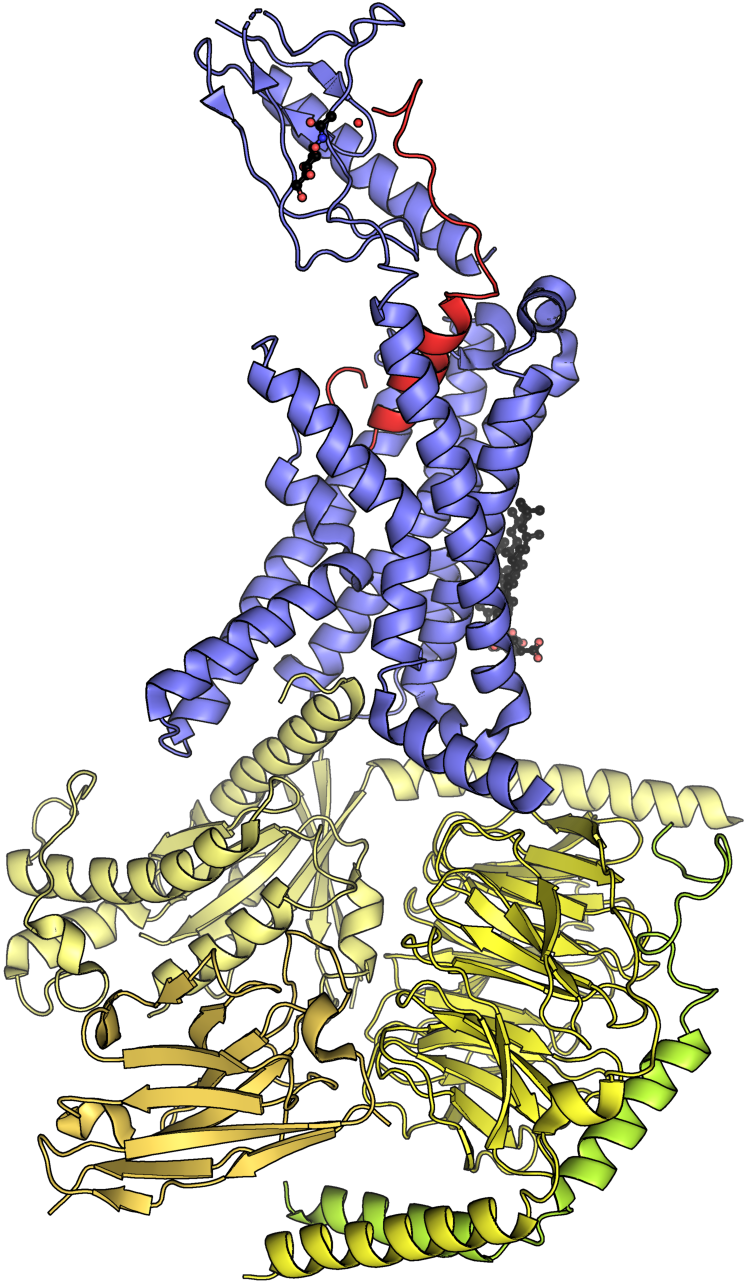|
Dual Amylin And Calcitonin Receptor Agonist
Dual amylin and calcitonin receptor agonists (DACRAs) are a class of drugs that act as agonists at the amylin receptor and calcitonin receptor that are under development as therapies for obesity and type 2 diabetes. Examples are cagrilintide, Petrelintide, ACCG-2671 and the KBP family derived from salmon calcitonin, including KBP‐042, KBP-066A, KBP-089, and KBP-336. References Amylin receptor agonists Experimental diabetes drugs {{gastrointestinal-drug-stub ... [...More Info...] [...Related Items...] OR: [Wikipedia] [Google] [Baidu] |
Amylin Receptor
The amylin receptors (AMYRs) are heterodimers of the calcitonin receptor and receptor activity modifying proteins (RAMPs). They are bound to by amylin with high affinity and consist of AMY1, AMY2, and AMY3. Amylin mimetics that are agonists at the amylin receptors are being developed as therapies for diabetes and obesity, and one, pramlintide, has been FDA approved. The AMY1 receptor may be activated by both amylin and the calcitonin gene-related peptide (CGRP) and could play a role in the effects of CGRP receptor antagonists developed for migraine. Dual agonists of the amylin and calcitonin receptors (DACRAs) are under development for obesity. Amylin and its receptors are believed to play a role in Alzheimer's disease Alzheimer's disease (AD) is a neurodegenerative disease and the cause of 60–70% of cases of dementia. The most common early symptom is difficulty in remembering recent events. As the disease advances, symptoms can include problems wit .... Refere ... [...More Info...] [...Related Items...] OR: [Wikipedia] [Google] [Baidu] |
Calcitonin Receptor
The calcitonin receptor (CT) is a G protein-coupled receptor that binds the peptide hormone calcitonin and is involved in maintenance of calcium homeostasis, particularly with respect to bone formation and metabolism. CT works by activating the G-proteins Gs alpha subunit, Gs and Gq alpha subunit, Gq often found on osteoclasts, on cells in the kidney, and on cells in a number of regions of the brain. It may also affect the ovaries in women and the testes in men. The function of the CT receptor protein is modified through its interaction with Receptor activity-modifying proteins (RAMPs), forming the multimeric amylin receptors AMY1 (CT + RAMP1), AMY2 (CT + RAMP2), and AMY3 (CT+ RAMP3). Preclinical studies have suggested that dual amylin and calcitonin receptor agonists may be more effective than amylin receptor agonists for obesity and type II diabetes. Interactions Calcitonin receptor has been shown to Protein-protein interaction, interact with Apolipoprotein B and LRP1. R ... [...More Info...] [...Related Items...] OR: [Wikipedia] [Google] [Baidu] |
Cagrilintide
Cagrilintide is a long-acting analogue of amylin. It is being tested to treat obesity and type 2 diabetes by itself and in combination with semaglutide as cagrilintide/semaglutide. Research A systematic review and metanalysis of cagrisema, published in 2024, found that cagrisema may provide weight loss benefits. References Amylin receptor agonists Experimental diabetes drugs Cyclic peptides Peptide therapeutics {{gastrointestinal-drug-stub ... [...More Info...] [...Related Items...] OR: [Wikipedia] [Google] [Baidu] |
Petrelintide
Petrelintide (development name ZP8396) is an amylin analogue dosed once weekly, developed by Zealand Pharma for the treatment of type 2 diabetes and obesity. Preclinical data suggests it may be more effective in combination with semaglutide. In June 2024 the company announced results for a Phase 1b trial, which found 8.6 percent weight loss over 16 weeks. In March 2025, Roche entered into an exclusive collaboration and licensing agreement with Zealand Pharma to co-develop and co-commercialise petrelintide as a potential foundational therapy for overweight and obese people. This development would focus on petrelintide, both as a standalone therapy and in a fixed-dose combination with CT-388 CT-388 is a "biased" dual GLP-1 and GIP receptor agonist/modulator with minimal to no beta-arrestin coupling at either receptor and is designed to be administered as once weekly subcutaneous injection. In a 24-week trial participants averaged 18.8 ... for overweight and obese people. Refer ... [...More Info...] [...Related Items...] OR: [Wikipedia] [Google] [Baidu] |
Salmon Calcitonin
Salmon calcitonin () is the type of calcitonin hormone found in salmon. Similar to humans, salmon calcitonin is a peptide hormone produced in the ultimobranchial region by parafollicular cells in response to hypercalcemia and lowers blood calcium and phosphate by promoting renal excretion. Composition Salcatonin is composed of 32 amino acids, of which 13 differ from human calcitonin. The structure of human calcitonin and salcatonin is as follows: ''Human calcitonin:'' H-Cys1-Gly-Asn-Leu-Ser-Thr-Cys7-Met-Leu-Gly-Thr-Tyr-Thr-Gln-Asp-Phe-Asn-Lys-Phe-His-Thr-Phe-Pro-Gln-Thr-Ala-lle-Gly-Val-Gly-Ala-Pro-NH2 ''Salcatonin:'' H-Cys1-Ser-Asn-Leu-Ser-Thr-Cys7-Val-Leu-Gly-Lys-Leu-Ser-Gln-Glu-Leu-His-Lys-Leu-Gln-Thr-Tyr-Pro-Arg-Thr-Asn-Thr-Gly-Ser-Gly-Thr-Pro-NH2 The cysteine in the first and seventh positions form a disulfide bond. Therapeutic usage Synthetic salmon calcitonin may be used therapeutically in humans, as it is twenty times more active than human calcitonin and has a longer ... [...More Info...] [...Related Items...] OR: [Wikipedia] [Google] [Baidu] |
Amylin Receptor Agonists
Amylin, or islet amyloid polypeptide (IAPP), is a 37-residue peptide hormone. It is co-secreted with insulin from the pancreatic β-cells in the ratio of approximately 100:1 (insulin:amylin). Amylin plays a role in glycemic regulation by slowing gastric emptying and promoting satiety, thereby preventing post-prandial spikes in blood glucose levels. IAPP is processed from an 89-residue coding sequence. Proislet amyloid polypeptide (proIAPP, proamylin, proislet protein) is produced in the pancreatic beta cells (β-cells) as a 67 amino acid, 7404 Dalton pro-peptide and undergoes post-translational modifications including protease cleavage to produce amylin. Synthesis ProIAPP consists of 67 amino acids, which follow a 22 amino acid signal peptide which is rapidly cleaved after translation of the 89 amino acid coding sequence. The human sequence (from N-terminus to C-terminus) is: (MGILKLQVFLIVLSVALNHLKA) TPIESHQVEKR^ KCNTATCATQRLANFLVHSSNNFGAILSSTNVGSNTYG^ KR^ NAVEVLKREPLN ... [...More Info...] [...Related Items...] OR: [Wikipedia] [Google] [Baidu] |
